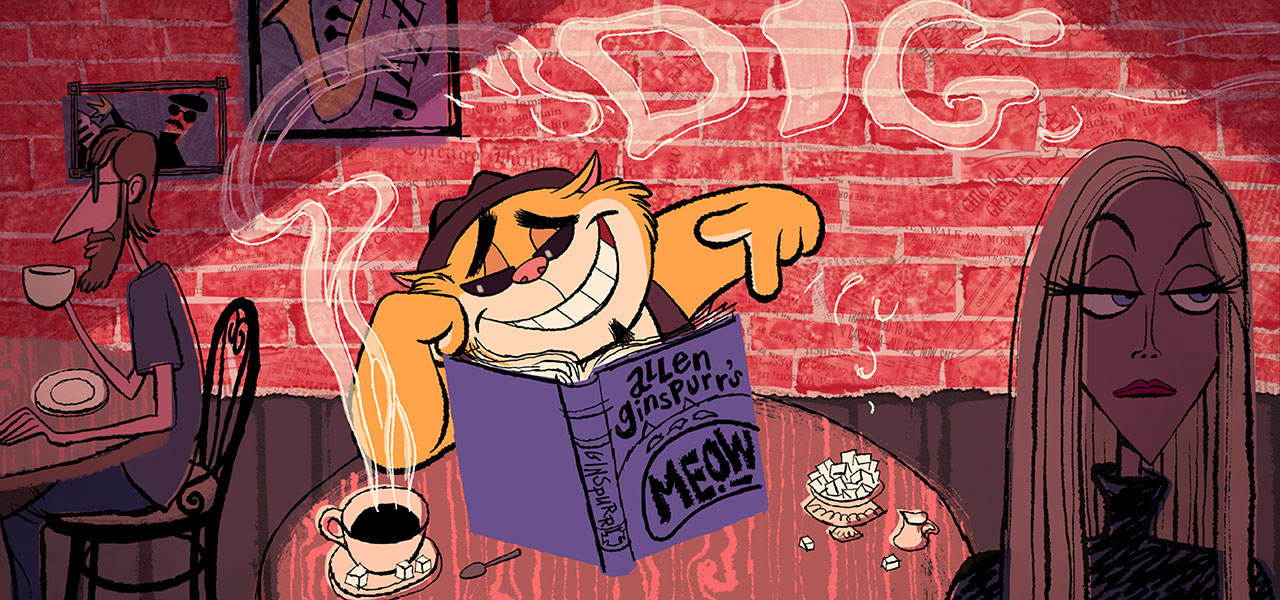
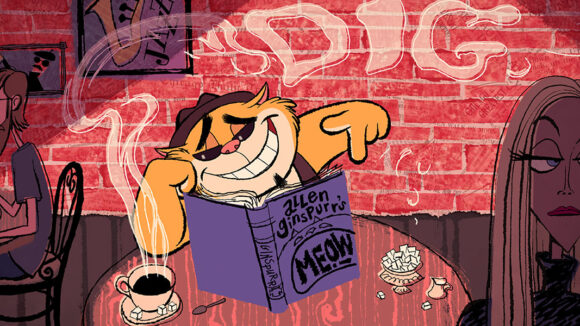
‘Aladdin,’ ‘Moana’ Director John Musker Goes Indie With Annecy-Debuting Short ‘I’m Hip’
Many will know John Musker as the writer and director (with Ron Clements) of many of Disney’s beloved animated features such as The Little Mermaid, Aladdin, Hercules, and Moana.
Aside from their rich characters and heartfelt storytelling, Musker and Clements’ films are recognizable for their exciting and well-animated musical sequences that fluidly transition from one scene to the next, taking advantage of the medium in delightful ways that only animation can. In Aladdin’s “Friend Like Me” sequence, the audience can’t help but smile, tap their feet, and sing along as the filmmakers, in the words of the Genie, “illuminate the possibilities” of animation.
Musker now continues that tradition of well-planned animated transitions with snappy timing and witty gags in a new four-minute short film he wrote, directed, and animated called I’m Hip. The film, about a self-absorbed cat who tries to convince the world of his ‘hipness,’ has its public premiere at the Annecy Festival, taking place this week in France.
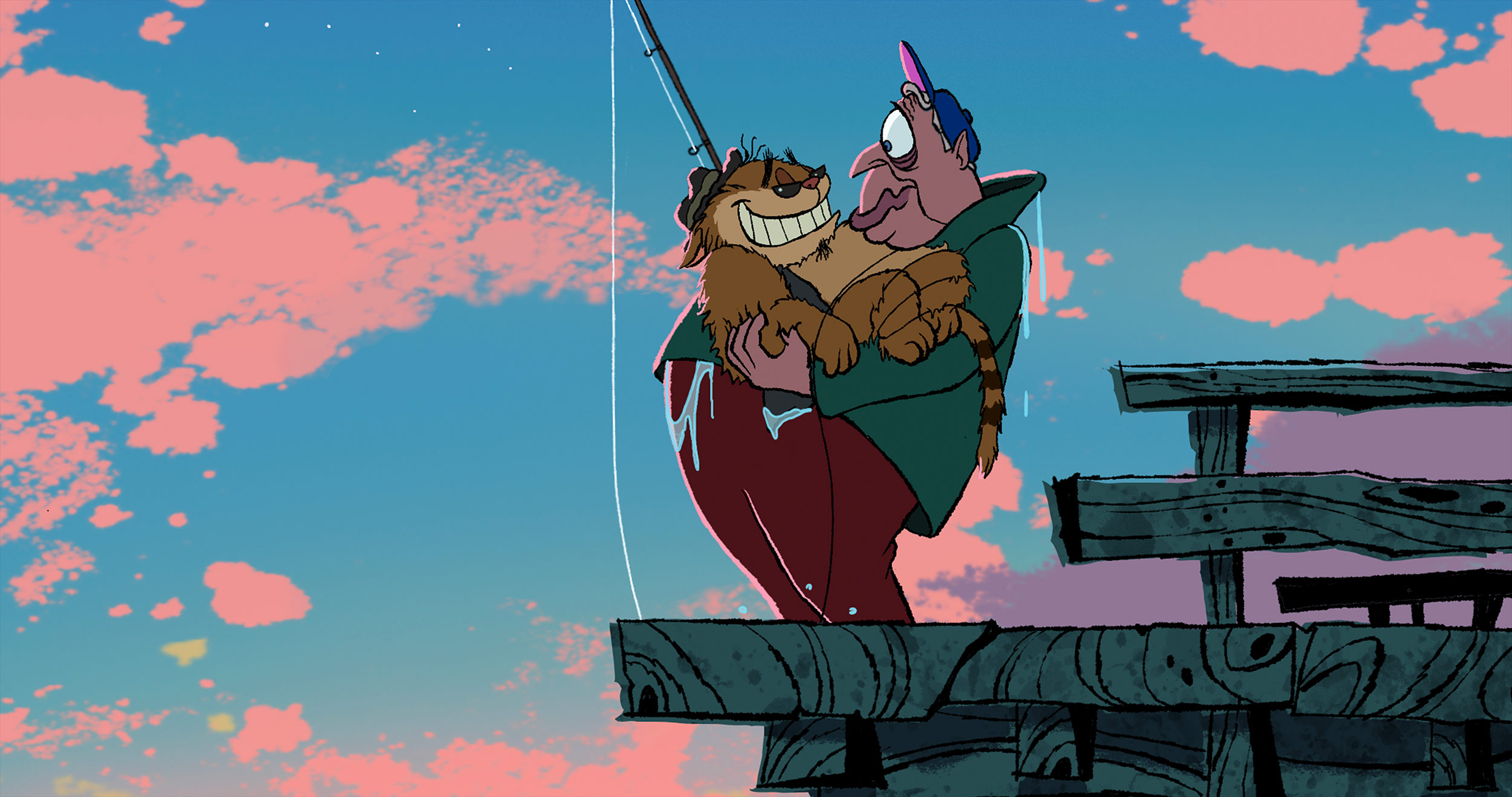
Musker designed and animated the short in its entirety (his first time animating in 40 years) enlisting a crew of ace clean-up, layout, and visdev artists, color designers, background painters, effects artists, and inkers and painters. Production began just before the pandemic and premiered at a crew, friends, and family screening at the Fine Arts Theatre in Beverly Hills last month.
Musker’s I’m Hip has four minutes of non-stop caricature cavalcade that will please any animation fan. The filmmaker, who is notorious among colleagues for his caricatures and studio gag drawings, designed and animated many of his friends, family, and colleagues from his forty-plus year career and scattered them throughout the film.
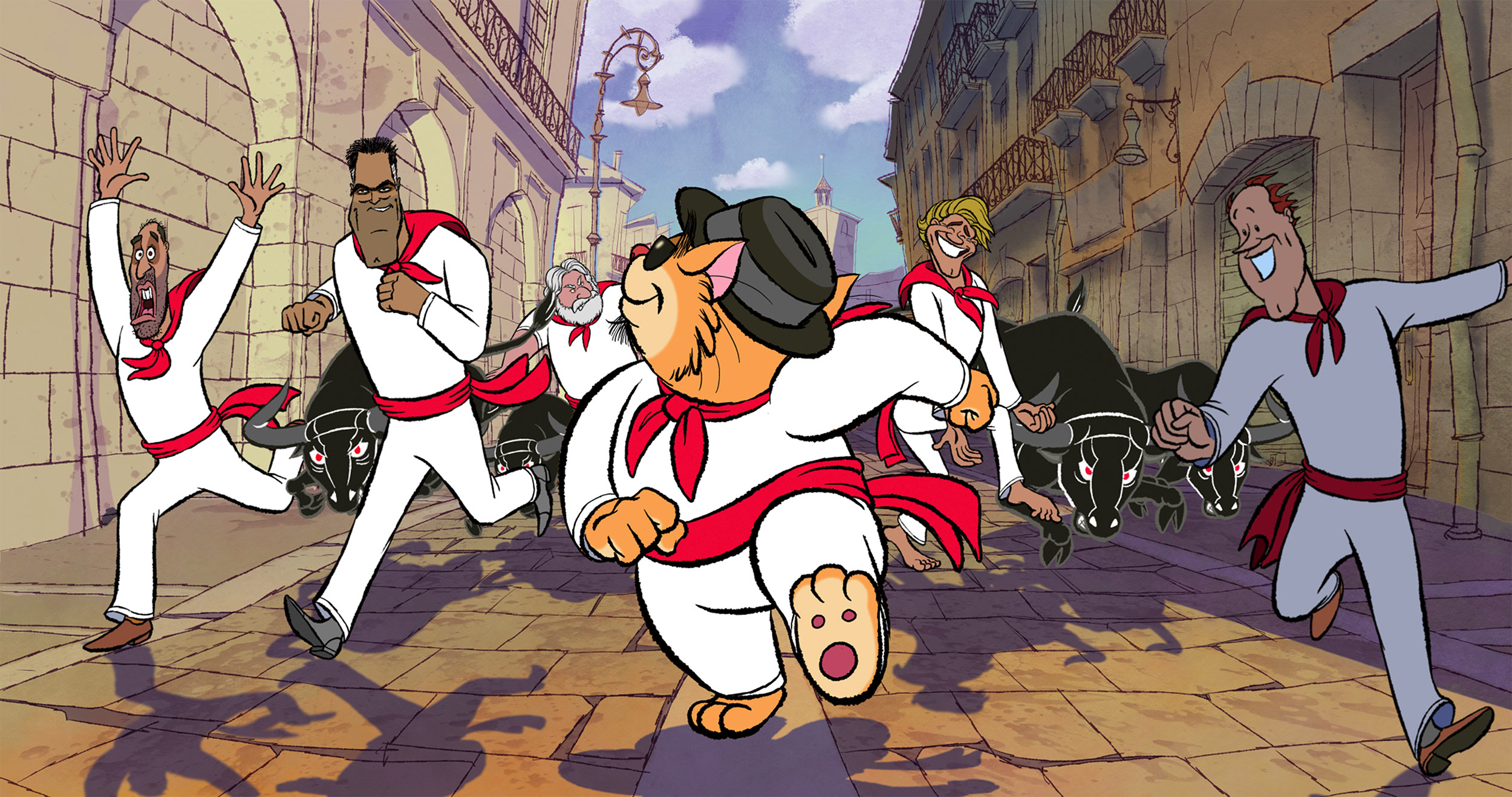
Many of the caricatures in the film are inspired by stories from Musker’s animation life. For example, in a Running of the Bulls scene set in Spain, a young Glen Keane is featured, alluding to a running contest at the Disney studio in the 1980s when Keane’s sprint was good enough to win the race but fast enough that he couldn’t put on the brakes and ended up crashing into a wall, blowing out his knee. Some of the artists later made a masking tape outline of Keane’s prone body on the floor like a police chalk outline. The audience may not know the story behind each scene, but it will feel there is one to be told.
After a celebrated career at Disney, I’m Hip proves that there’s life after Disney. We recently sat down with Musker to pick his brain about the film.
Cartoon Brew: When did you start making this movie and how long did it take?
John Musker: I spent four years making this movie, roughly. It began pre-Covid and continued after Covid’s waning.
What inspired you to make this short?
I tinkered with the idea over the years a little bit, but it was only after my retirement from Disney in 2018 that I seriously thought about making a short based on this song. I had various ideas for different shorts I wanted to animate. I began my career as an animator and I wanted to try my hand at it again, even if I hadn’t really done it for 40 years. That sounds crazy, doesn’t it? So, guided by my wife Gale’s suggestion as to the type of short I might make, namely, “Do something funny,” I returned to I’m Hip.
Why did you choose this song?
I first heard the song, “I’m Hip” in the 1980s. It was originally written by Dave Frishberg and Bob Dorough as a comic set piece for Blossom Dearie, a unique and stylish cabaret performer who played piano and sang in a feathery voice. It’s been “covered” over the years by several singers. I always thought that Frishberg’s comic delivery of his witty lyrics, which make fun of people so desperate to be thought of as “hip” – and those kinds of people never go out of style – coupled with Frishberg’s sardonic piano playing on top of a cool bass and drums rhythm section, would make for an entertaining animated short. Ron Diamond, a colleague I have known for many years, helped me navigate securing the rights to the song, without which nothing could happen.
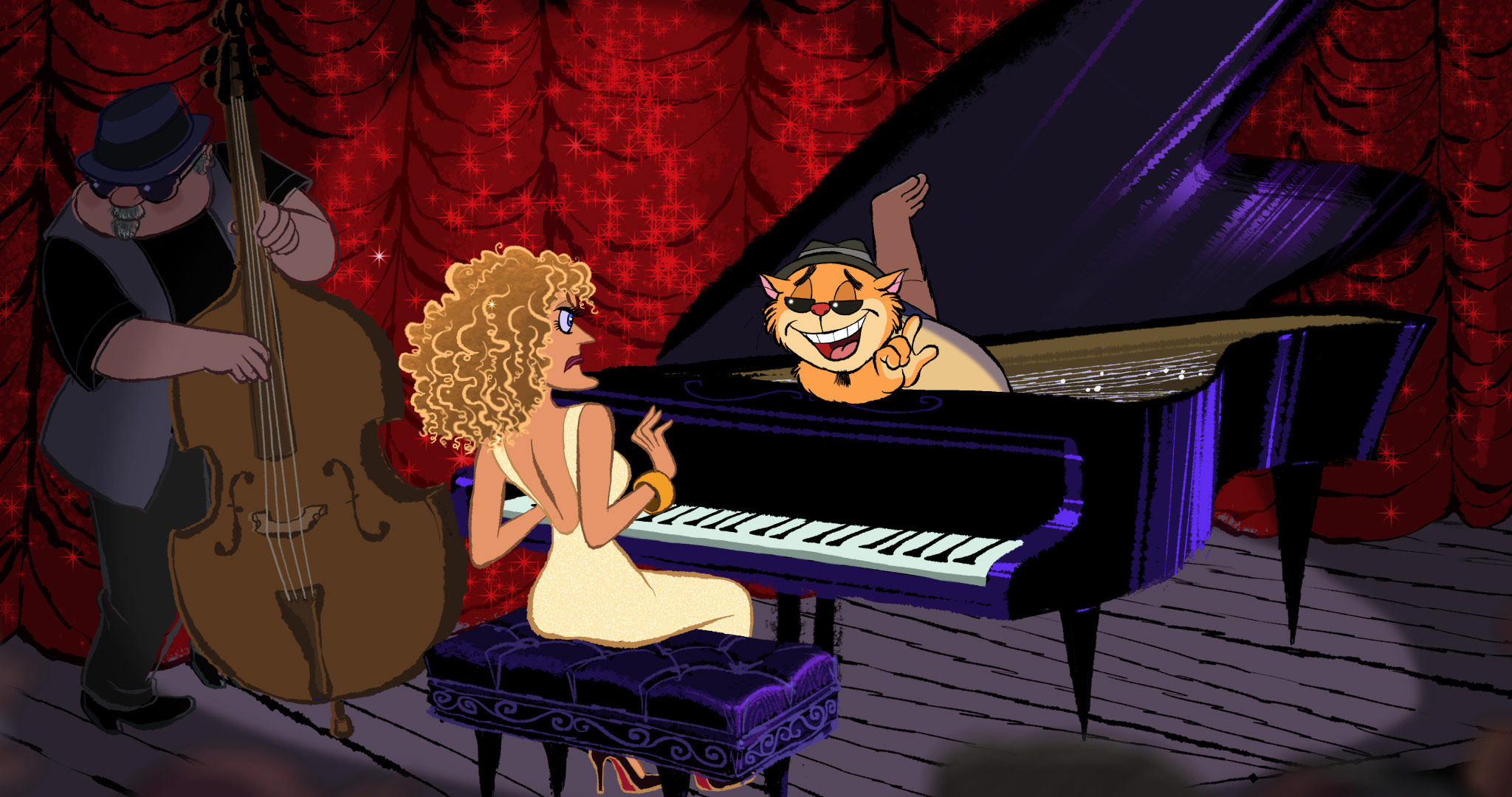
I wanted the film to be a celebration of jazz and Frishberg’s song, but I also wanted it to be a love letter to hand-drawn animation. Although the film has a certain amount of 1950s and 1960s vibe, I didn’t want to do limited animation which came in vogue during that time. I really wanted to do “full animation” with drag, overlap, squash and stretch, and a certain degree of volumetric drawing with 2d cheats and things on ones when needed. I wanted to celebrate the magic of unapologetic drawings coming to life and seeming to move, in a caricatured fashion, of their own will. I was inspired by Disney greats like Ward Kimball and John Lounsbery, but also people like Ken Harris, Eric Goldberg, and Preston Blair. And by the cover art of jazz albums of that period, especially the work of David Stone Martin, and to a lesser extent, the great Jim Flora, to whom I designed one shot as a kind of homage.
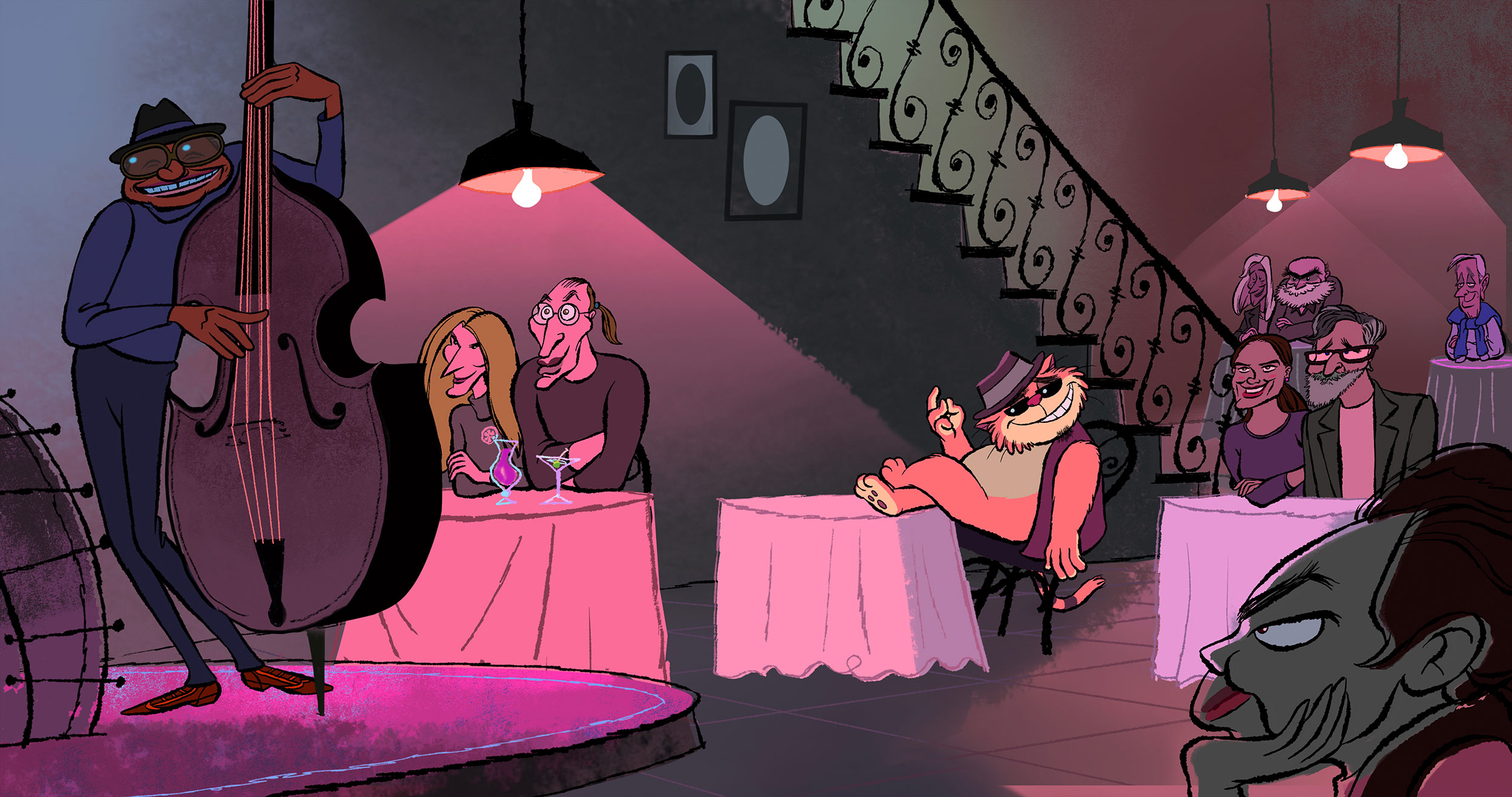
How did you decide whom to caricature in the film and the context in which you put them?
I knew early on that I wanted to put cameos of all the smallish crew who worked on I’m Hip into the film. I have been a caricaturist for many years. I never earned a living from them, but enjoyed doing ones of friends, family members, and co-workers. But as I got into the short, I had several shots where my lead character, this hipster cat, interacted with people or passed through places that have people in them. I was going to have to design and animate these “extras,” and I thought why not draw people I know into these roles? In the art house movie theater, for example, where the cat goes on a date with his arty girlfriend Imogene, I thought I would fill the theater with mostly couples who are filmmakers or movie enthusiasts. So seated beside and around the cat and Imogene are Henry Selick and his wife Heather, Brad and Liz Bird, Jerry and Rebecca Rees. Also appearing is film critic Charles Solomon and his partner Scott Johnston, layout artist Jennifer Yuan and her husband Mark, Disney publicists Howard Green and Mike Bonifer, my sister Mimi and her film professor hubby Dan Dinello, and college roomie Harry Sabin and his friend Beth Herzhaft. Also lurking is film impresario Ron Diamond.
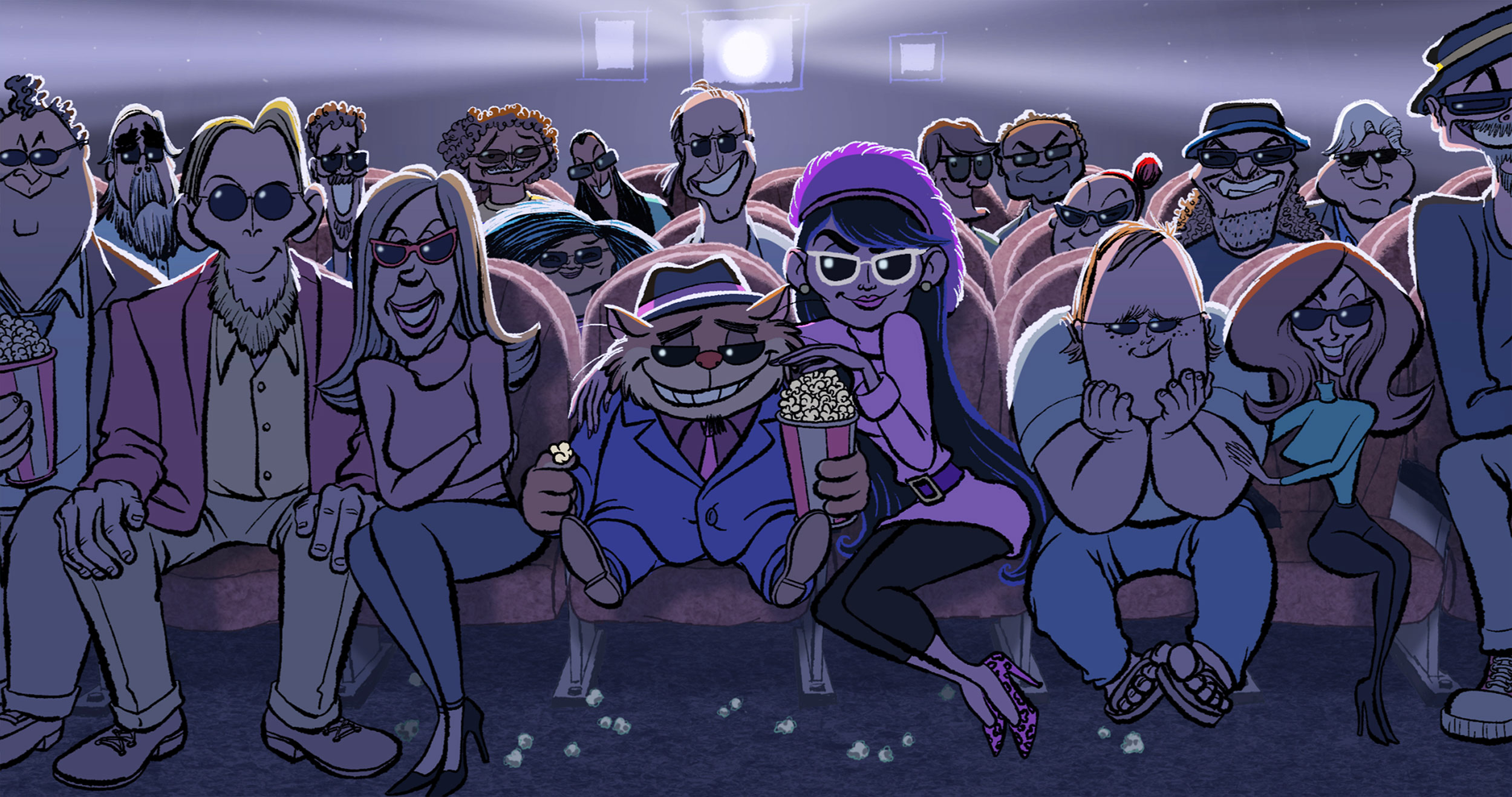
I couldn’t resist the temptation to drop in caricatures of big animation influences like Ward Kimball or my mentor Eric Larson. Or Disney legend Floyd Norman, who plays stand-up bass in one early scene, or Marlon West, effects supervisor at Disney and jazz enthusiast whom I drew playing a cool set of drums. When I finished, I realized there were over 120 caricatures sprinkled around the movie. I hadn’t envisioned that when I started.
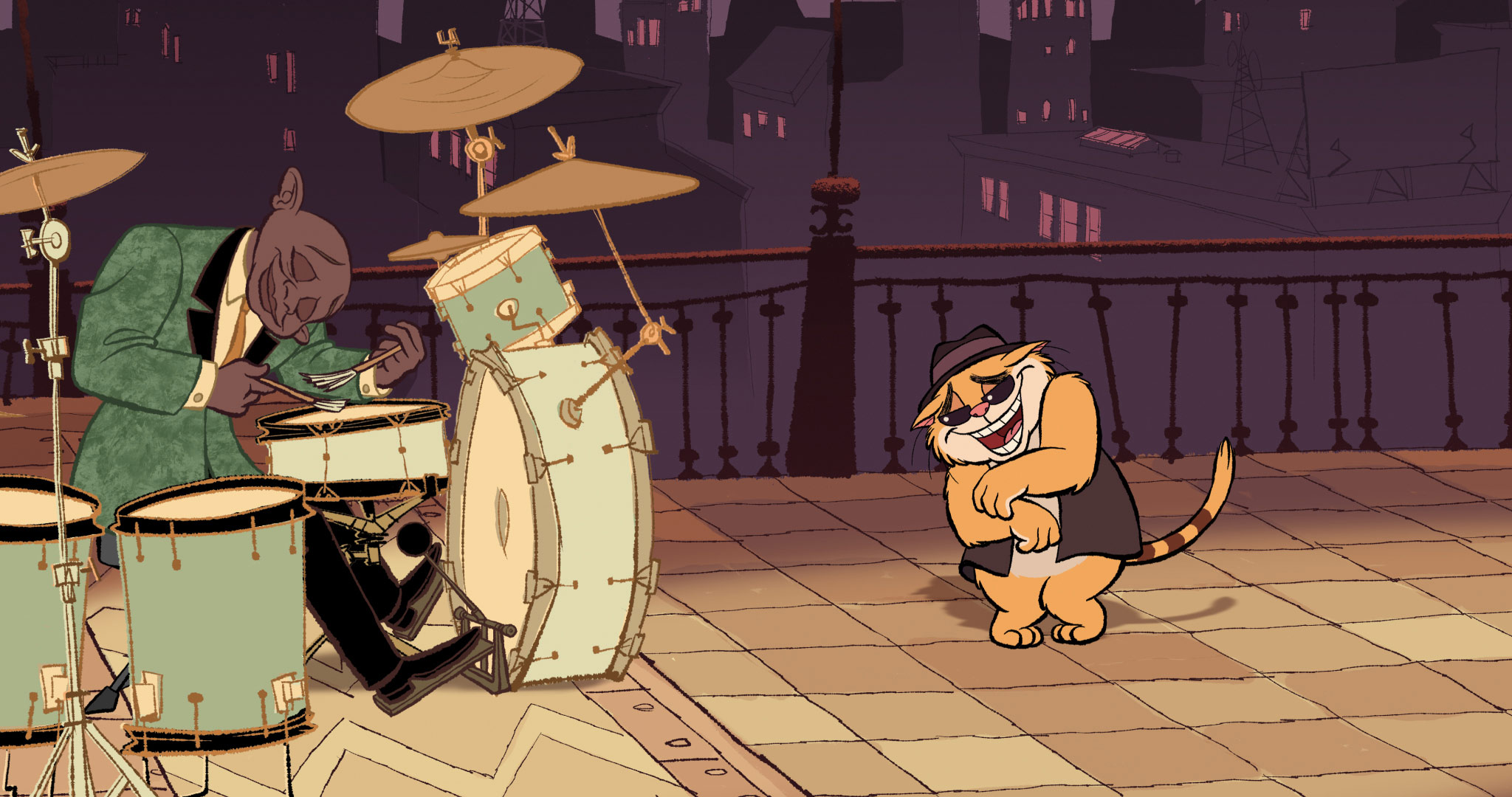
After a career of making large-budget films, how did it feel to make an independent film? Did you make decisions differently and were there compromises you had to make along the way?
I produced the film myself and paid everyone who worked on it. I wanted to maintain creative control over everything, so I didn’t want to be beholden to people with money who would want input. I relished the opportunity after many years of making big budget features where admittedly I had a great deal of control, but not the final “say” on things, to just go with my gut. No committees, no focus groups. Just me and my crew.
In 2019, I completed the scratchy storyboard for the film. I decided, based on various recommendations, to use TVPaint, a French software, to make my hand-drawn film which I drew on my Cintiq. I had considered doing it on paper as I had 40 years earlier, but I found TVPaint gave me several options on the line quality and the ability to work in layers and to cut, copy, paste, and transform things, so it was a good fit for me.
My goal was to design all the characters and to animate them all myself, all four-minutes worth of them. I am happy to say I did that, with the enormous help of brilliant clean up artist Dan Tanaka, who keyed all my scratchy animation drawings, and folks like Rachel Bibb and Dietz Ichishita and others who helped complete the clean-up. I named my production company Scribbly Pictures, and for good reason. I am a notoriously scribbly animator. God bless Dan Tanaka.
Of course, while I was making it, I drew on the ideas of others working on the film. John Ramirez did great visual development and had some story suggestions. Claudio Acciari, a brilliant Italian artist, did wonderful color and background ideas that made their way to the screen. Layout artist Jennifer Yuan had witty ideas for the settings that I hadn’t thought of and Ken Slevin, an Irish background painter and art director, did most of the backgrounds following a color script by Disney legend David Goetz, who brought a number of great additional visual ideas to the color of the film. I didn’t have an end title sequence yet when David did his color script, so that was all Ken, who did the layouts for that as well. I love what he did.
I had great effects work done by the late Kathleen Quaife, who was an exceptional 2d artist. And Sam Fleming also did shadows, bubbles, and rubble. And Disney vet Eric Daniels did some amazing prop fx animation in both 2d and 3d with billiard balls, falling pianos, and literally the kitchen sink.
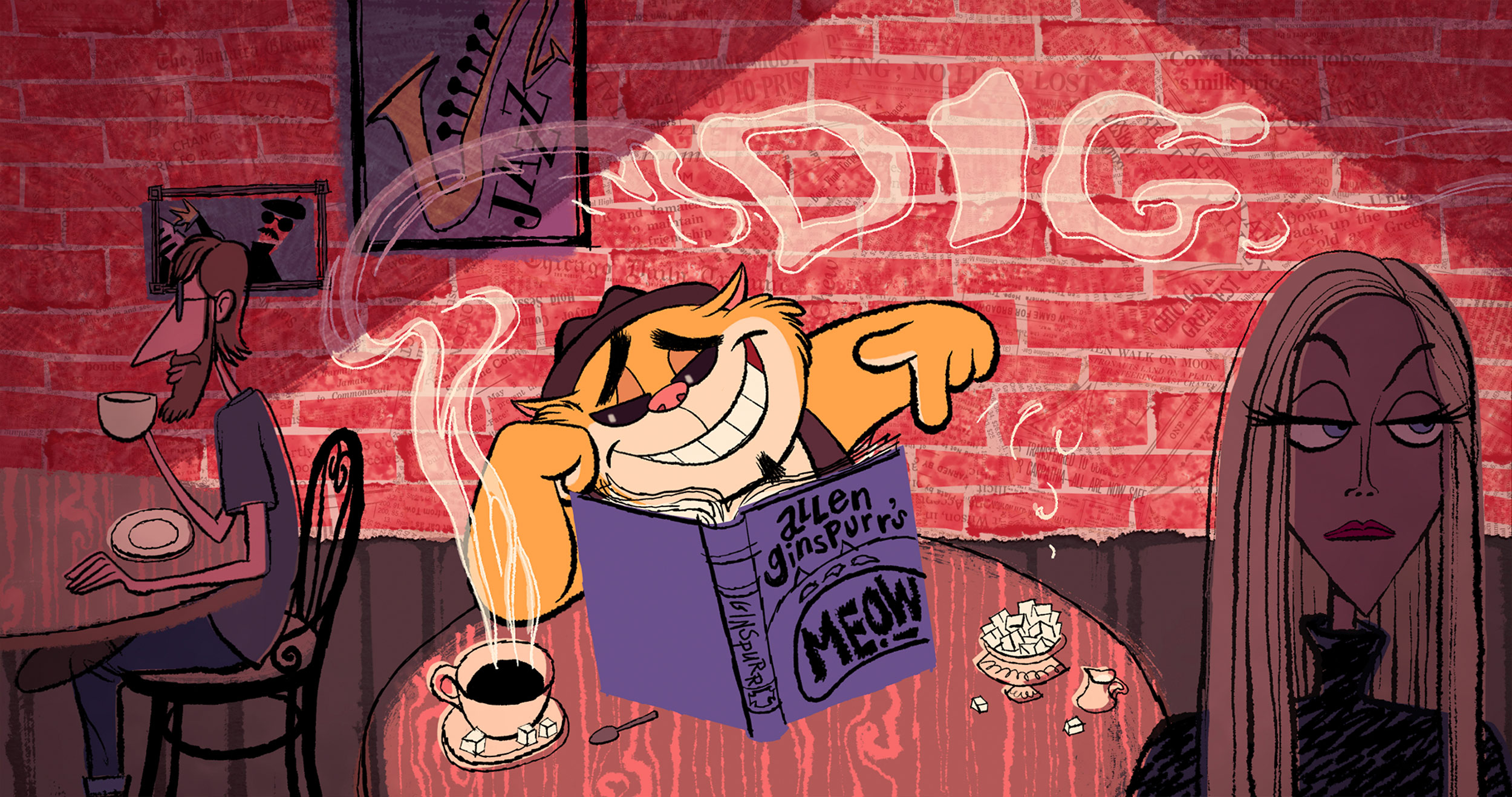
But my biggest ally in all of this was Talin Tanilean, who wore many, many hats on this film. She knew not only TVPaint backward and forward, but she also was comfortable in After Effects with which she composited everything and did all the final camera work. She knew Adobe Premiere where all the shots were assembled. She got all the work from clean-up into ink and paint where sisters Bethany and Olivia Moy painted it. She was organized and efficient and did a million other things as well like additional shadows and highlights and repos and you name it. I could not have done this film without her. And she was always a joy to work with.
Were there any particular challenges you overcame or techniques you learned while making this film?
I hadn’t animated in many years, but I had continued to draw all this time. I dug out my copy of Eric Goldberg’s Character Animation Crash Course and my Preston Blair books and just dove into the deep end of the pool.
I have to admit, when I did my first little scene and rough inbetweened it and then played it at speed, I actually got a thrill out of it. The cat was moving, and he seemed alive like all the animation I loved. He was a drawing, but a living drawing. Some scenes of animation came fairly easily to me but others I struggled with. At times I would shift frames from one shot to another to have poses read more clearly. In general, my first approaches were sometimes too busy, and I had to simplify. I rough inbetweened everything very crudely just to test my timing because I didn’t have confidence that it would work. I was up to some of my CalArts bad habits like not numbering my drawings. I would pose extremes and then put in breakdowns and inbetweens until I felt the timing was right. Then I would go back and number them and chart them for clean-up. All the while I was trying to apply lessons Eric Larson had taught me years before about the change of shape, strong silhouettes, good strong arcs, and paths of action.
I had never worked with TVPaint before but fortunately, I had David Nethery as my guru. We would Zoom or Skype and he would show me how the program worked. I had downloaded some third-party brushes to get a scratchy pen and ink thick and thin line, which I felt went with the style of a lot of the period.
I didn’t have the incredible production support system that we were blessed with at Disney; a lot of bright, hardworking people who helped get the film to the screen. It fell to me and, fortunately, to Talin to not let things get hung up. I also have osteoarthritis, particularly in my hands, so the increased load of drawing took its toll on my crooked fingers and painful knobby knuckles, but it was manageable.
What did you learn from taking on this endeavor? And are you considering making more shorts?
Overall, it was a lot of work but also a lot of fun. I love the way animation can work to music. I have a number of other short film ideas that are all built around various pieces of music, although they vary in terms of style, length, and tone. After I’m Hip makes its circuit of film festivals, I may begin another short. Time will tell.
Interview edited for length and clarity.
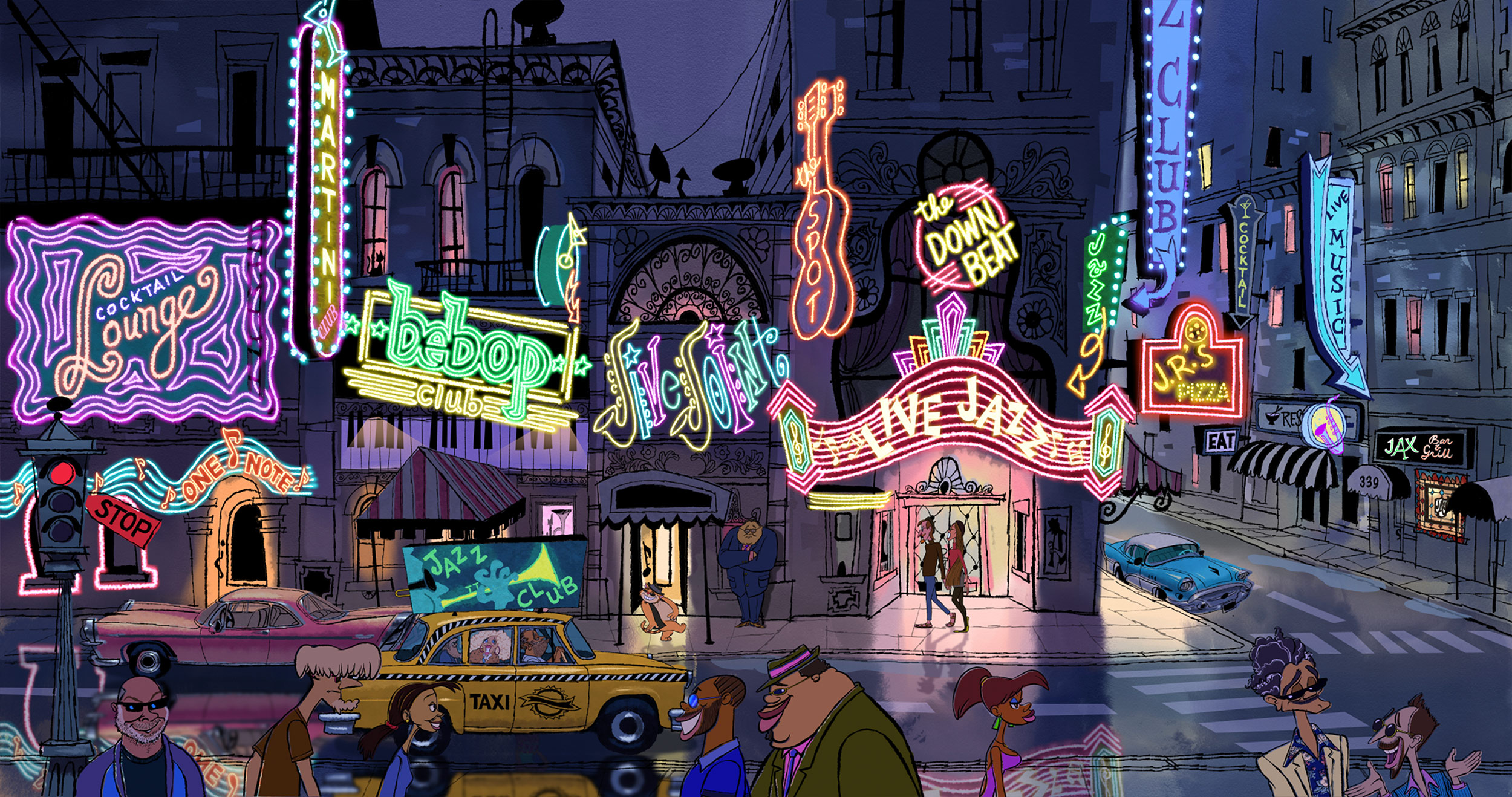

.png)